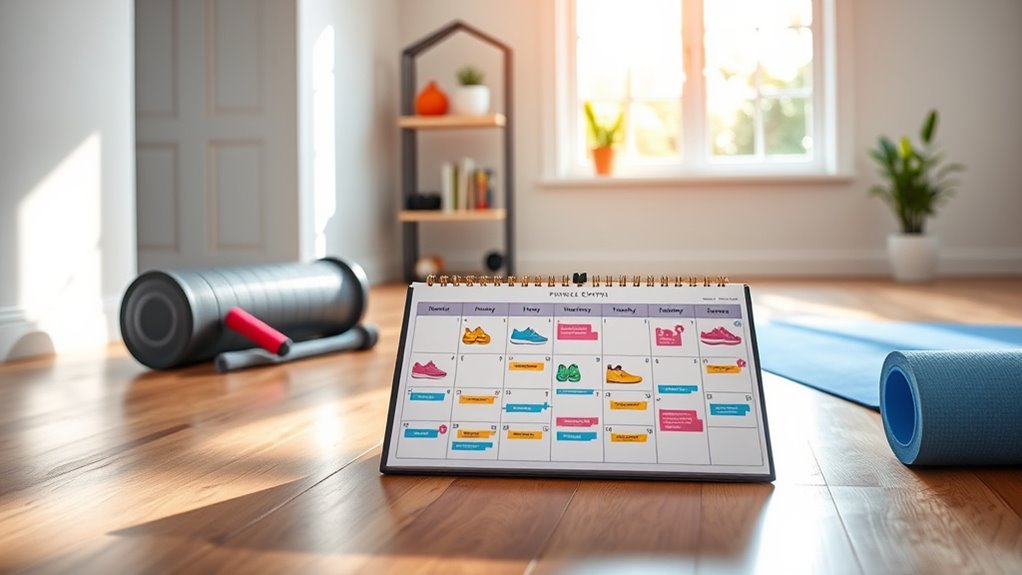To balance fitness and recovery, plan your week with a mix of high-intensity workouts, strength training, and light or rest days like yoga or walking. Fuel your body well with proper nutrition and stay hydrated to support muscle repair. Always warm up beforehand and listen to your body’s signals to prevent overtraining or injury. Adjust your plan based on your progress and how you feel, ensuring sustainable improvement—continue exploring for even more effective strategies.
Key Takeaways
- Alternate high-intensity workouts with lighter activities or rest days to prevent overtraining and promote recovery.
- Schedule specific days for strength training and active recovery, like yoga or walking, to ensure balanced progress.
- Incorporate proper nutrition before and after workouts to fuel performance and facilitate muscle repair.
- Include warm-up, stretching, and mobility exercises to reduce injury risk and improve flexibility.
- Monitor your body’s response and adjust workout intensity or recovery time to maintain optimal balance.

Achieving your fitness goals isn’t just about pushing yourself harder; it’s about finding the right balance between training and recovery. One of the most effective ways to do this is by carefully designing your weekly workout plan, ensuring you incorporate proper nutrition planning and injury prevention strategies. When you prioritize these elements, you set yourself up for progress without risking burnout or setbacks.
Start by scheduling your workouts thoughtfully. Mix high-intensity sessions with lighter activities or rest days to give your body time to recover. This balance helps prevent overtraining and reduces the risk of injury. For example, if you focus on strength training on Monday, Wednesday could be dedicated to active recovery like yoga or walking. This variation allows your muscles to repair and adapt, improving your overall performance over time.
Nutrition planning plays a *fundamental* role in supporting your workout schedule. Fuel your body with the right nutrients before and after exercise to optimize recovery and performance. Carbohydrates replenish glycogen stores, while protein aids muscle repair. Incorporate balanced meals that include lean proteins, whole grains, healthy fats, and plenty of vegetables. Staying well-hydrated is equally important, as dehydration can impair recovery and increase injury risk. Proper nutrition not only enhances your energy levels but also fortifies your immune system, helping you stay consistent with your workouts. Additionally, understanding training principles can help tailor your plan more effectively to your goals.
Injury prevention should be a *primary* priority in your weekly plan. Warming up properly before each session prepares your muscles and joints for activity, reducing strain and the likelihood of strains or sprains. Incorporate dynamic stretches and light cardio to loosen up. Equally important is listening to your body—if you feel pain or excessive fatigue, don’t push through it. Rest days are *essential*; they allow your muscles and tissues to recover, preventing overuse injuries. Investing time in mobility work and stretching can further enhance flexibility and reduce tightness that might lead to injury.
Finally, tracking your progress and adjusting your plan accordingly keeps you on the right path. Pay attention to how your body responds to different workouts and recovery days. If you notice persistent soreness or fatigue, it might be time to modify your intensity or add more recovery time. Remember, balancing fitness and recovery isn’t a one-time effort but an ongoing process that demands attention to nutrition, injury prevention, and listening to your body. When you do this, you’ll find yourself making steady progress while staying healthy and motivated.
Frequently Asked Questions
How Can I Tell if I’M Overtraining?
You can tell you’re overtraining if you notice signs of fatigue like persistent soreness, irritability, or declining performance. Pay attention to your training frequency—if you’re pushing too often without proper rest, it increases overtraining risk. Your body needs time to recover; if you’re feeling exhausted even after sleep or experiencing frequent injuries, it’s a clear sign you need to scale back and incorporate more rest days.
What Are the Best Recovery Techniques for Sore Muscles?
To ease sore muscles, you should incorporate stretching routines and foam rolling into your recovery. Stretch gently after workouts to improve flexibility and reduce tension. Foam rolling helps release muscle knots and increases blood flow, speeding up recovery. You can also try light activity like walking or swimming, stay hydrated, and get plenty of sleep. These techniques work together to relieve soreness and prepare your body for future workouts.
How Does Sleep Impact Workout Recovery?
Think of sleep like charging a phone—without it, your recovery stalls. Good sleep quality boosts recovery hormones, helping muscles repair faster and reducing soreness. When you sleep well, your body releases growth hormone, essential for muscle growth and repair. Missing out on quality sleep prolongs recovery and hampers progress. Prioritize sleep, and you’ll wake up feeling stronger and ready to crush your workouts, turning rest into your secret weapon.
Should I Take Rest Days if I Feel Energized?
Yes, you should take rest days even if you feel energized. Rest days offer vital benefits like muscle repair, preventing injury, and avoiding burnout. They help maintain an ideal workout frequency, ensuring you stay consistent and avoid overtraining. Listening to your body is key; feeling energized doesn’t mean your muscles are fully recovered. Incorporate rest days into your weekly routine to maximize performance and long-term progress.
Can Nutrition Influence My Recovery Speed?
Yes, nutrition can greatly influence your recovery speed. When you focus on nutrient timing, you help your muscles replenish glycogen and repair faster. Staying well-hydrated with effective hydration strategies reduces muscle fatigue and soreness. Consuming protein and carbs after workouts boosts recovery, while proper hydration ensures nutrients reach your muscles efficiently. Prioritize balanced meals and hydration to optimize your recovery and keep your fitness momentum going strong.
Conclusion
Remember, mastering your weekly workout plan means finding that perfect balance between pushing your limits and allowing time for recovery. By blending bold bouts of activity with gentle, grounding rest days, you create a cycle that sustains your strength and stokes your stamina. Stay consistent, listen to your body, and let your dedication drive your progress. With mindful movement and measured rest, you’ll build a brighter, balanced fitness future that fuels your fire and fosters your fitness flair.









